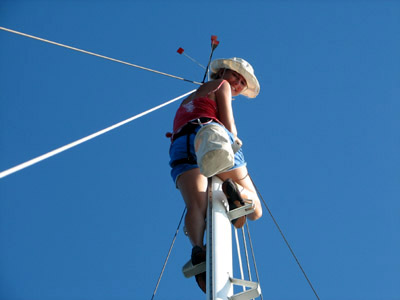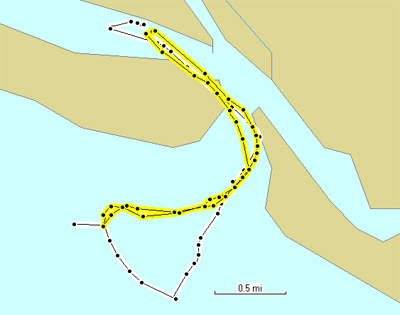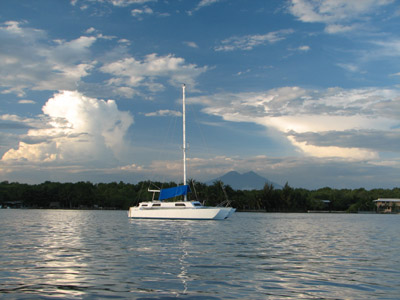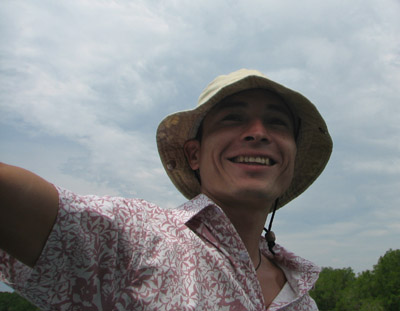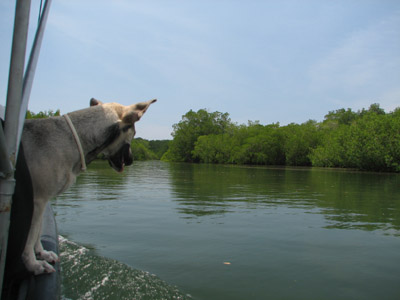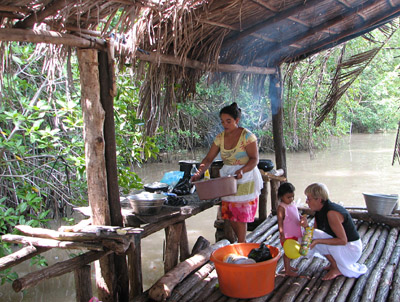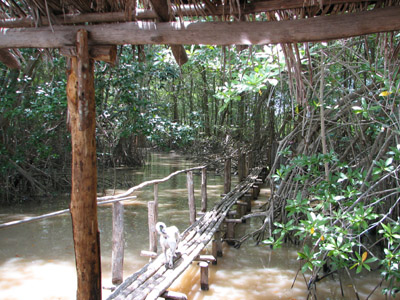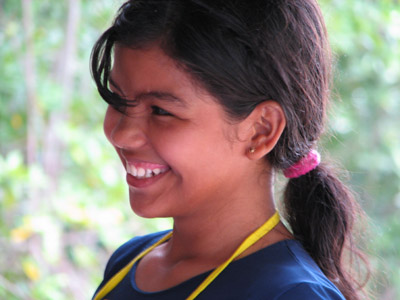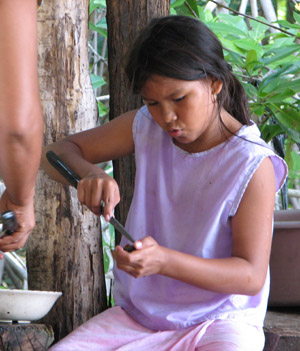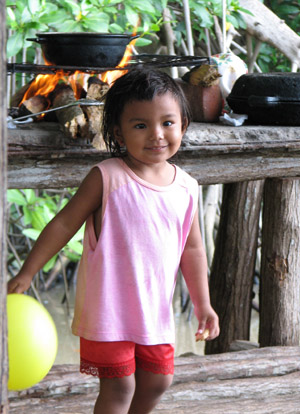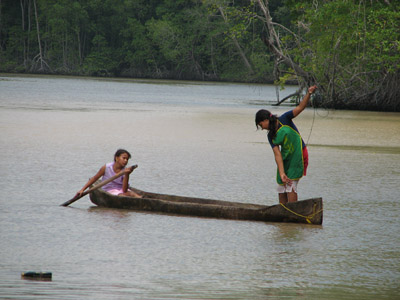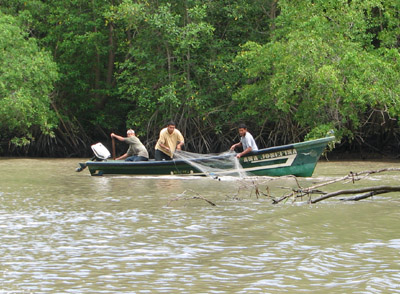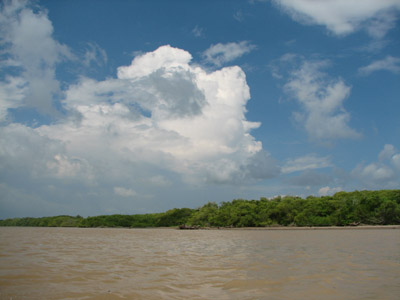Escape from Bahia del Sol!
Tuesday, October 17th, 2006Starting Friday before our planned departure (Monday or Tuesday), we began making the trek across to the ocean side every morning at high tide to observe the bar. Joshua’s dad had arrived the day before and we had only to do a few hundred small things before we were ready to leave—and we were ready to leave. Like yesterday. Last month!
Friday’s bar was ugly. We sort of gazed at it without saying anything trying to pick out the so-called ‘channel’ and exit point. Breakers were all the way across and coming from two different directions, causing some gnarly looking turbulence. Every so often though, there would be a bit of a lull where you could imagine maybe jetting across before the next set came in. Our boat, under power, is unfortunately incapable of achieving anything close to ‘jetting’ and so we were dismayed. Jeff said, “You have to go through THAT? Well, we can always just stay here if the swell is too big.â€

[Saturday’s bar. You have to sail between those sets of breakers for a mile or so.]
Saturday we wandered over after a tasty pupusa breakfast to check it again. And it looked great! As good as we have every seen it, in fact. We had to restrain ourselves from running back to the boat to take off that moment because it may never be so calm again. Sunday also was good, although the swell was a little bigger. “The waves were more defined,†was Jeff’s tactful way of putting it. We still needed to provision vegetables and were not feeling optimistic about getting the necessary navy and immigration paperwork completed on a Sunday. We decided upon a Tuesday departure, conditions holding.
Monday was spent running around doing all the last minute stuff. The navy guy filled out our ‘zarpe’ (clearance) in such a slow unsteady hand that I wondered whether he had been maybe accidentally shot in the head at one point. But he was very nice and he would pronounce each major term carefully in English for us while we congratulated him on his fluency. “Last. Name.†“Clear. Rance.†(Beaming.) It took him about an hour to fill out the nine or so blanks required on the form and we finally staggered back out into the sun with our Clear Rance. I tracked down the Immigration Guy, a man who processes maybe two or three forms every month or two and is supposedly available “twenty-four hours in the day,†but he was very busy in the bar drinking coke and watching Chuck Norris putting some right back into the world (i.e., kicking ass and quipping bad puns in his gruff, all-business voice); he told me to come find him again in an hour or two. We then spent an excruciating number of hours gathering vegetables for the trip, for which we had to take a bus all the way to Zacatecoluca. Finally, by the end of the day we had our food and the Immigration guy managed to fit us into his tight schedule (Maria Querida, a soap opera, came on sometime in the early evening and there was no way work could be done during the show.)
Tuesday we ate our last El Salvador pupusas and walked over to check the bar at three hours before high tide; it looked okay—a little rough but we were hoping that was due to the tide and not the swell. We went back to the boat to take the dinghy apart and hook the motor back up to the boat. Jim and Susie from Sparta dinghied over to say goodbye and then headed out ahead of us to watch our departure. There was actually some wind and we pulled anchor under power and full sail and headed for the bocana (mouth) of the estuary.
As we made the first turn into mouth before the channel, we took the main down because the turbulence was knocking the wind out of the sails. Jim and Susie were motoring along beside us with their dinghy and Peter from Sereia also was following us out with his inflatable. Going was slow but the deeper section was clearly defined, if rather confused and choppy. We had stacked all our extra jugs of water as far back as we could inside the boat and Jeff sat on the stern to add additional weight and babysit the motor. We could hear it pulling out of the water and cavitating and Jeff reported that it had been dunked completely under water twice, a thing that little motors generally do not like, but it kept running with only a few alarming lulls in power. Once outside the bocana, we turned to the right and ran in between breaking sets of waves. The breakers coming in from the outside would rear up and either fall off or break and flatten out before they got to us, then they would again break on the other side of us. This part was the creepiest—it was stressful and just took forever; however, the sea in the channel was much smoother with no confusion. Jim and Susie and Peter couldn’t go any further than the first turn out the bocana and they already looked like tiny specs. We got to the end of the channel after a largish set passed and turned out, passing over the bar in around 14 feet of water. FREE!

[View from OUTSIDE the bar.]
We kept the motor running until we had cleared 50 feet of depth and then turned towards Nicaragua and Costa Rica. Wind was light—maybe less than ten knots—and we sailed quietly for the rest of the day. Towards evening the wind died and we started the outboard and arranged watches; I ended up with the 2-6am watch and when I got up, there was an ominous black smudge blocking the horizon right where we were supposed to go. Joshua went to bed with the words, “yeah, you might get wet.†Crap. I fretted about the storm for a while and then decided to take action and dodge it. I altered course 30 degrees and strained my eyes see if I was making any headway. Dodging a storm is not as exciting as it seems when you are bouncing around at 3 knots. I kept thinking that the black smudge was moving away from my spreader mark-point only to discover that I had drifted off course and it really had not moved perceptibly at all. Two hours later though, progress had been made and I had passed it halfway. Now, I could see all the lightning on the other side and got stressed out all over again. Finally everything disappeared when it got light at 5:30am. Neither Joshua nor Jeff had any significant sign of weather during their watches at all.
The next morning we woke almost to the eastern edge of the Gulf of Fonseca. I crashed out for a while and suddenly this wind hit. We were several miles offshore and with the wind blowing off land, we were in some ugly steep chop. I bounced around in the bunk while trying to nap until I couldn’t stand it anymore and got up to assess the situation. The sails were double reefed and Joshua and Jeff were chatting nonchalantly while trying to keep themselves in their seats. Bleah. The wind lasted several hours with us pointed as high as possible into it to keep from getting too far off land. By night we finally were closer to land (as the wind finally slacked off) and passing Corinto, Nicaragua’s major shipping port. I took first watch this time in hopes of avoiding those early morning squalls and proceeded to keep Jeff awake all night putting the sails up and down as the wind shifted annoyingly around. I think both the main and the jib went up three times and down three times by the time I was finished and finally Joshua took over as the wind kicked up. Again, we got pummeled by the gnarly off-shore wind while I tried to sleep. Jeff was in danger of being tossed from his bunk on the high side so he got up to ‘sleep’ in the cockpit. Two reefs went in and finally they took the mainsail down entirely, running on jib alone, to keep the boat from bouncing all over hell and gone. The wind lasted four or five hours and then mostly died.
The next day we had strong but steady wind. This time we were comfortably close to land and were able to sail smoothly and quickly. I had been totally irritated by the periods of either no wind or very strong wind and choppy seas of the previous days but after a day of regular wind and not having to think about starting the motor, I pretty much forgot about the un-fun bits. The strong wind was also tiring; we double-reefed and reduced sail to the storm jib (like the size of a napkin) after we busted our cheek block (holds the jib sheet) and had to jury-rig a substitution. We decided to take a break and arrived to a small anchorage listed in the Forgotten Middle as “No-Name Bay.†Actually, it did have a name—as did the small village (El Astillero)—and it was an awesome anchorage. We ate cooked food and slept and Joshua and Jeff went ashore under the pretext of needing fuel to check things out (we did not want to hassle with checking into Nicaragua and this anchorage wasn’t supposed to have the facilities to do this). There was in fact a navy guy in this village and he was interested in why we were there, but after they explained, he was happy to let us just hang out for the night and buy fuel (and ice!).
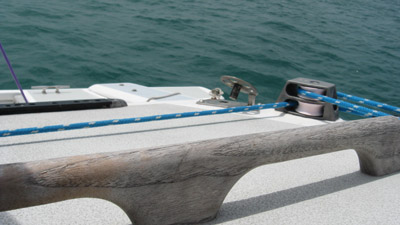
[Broken cheek block is that wanged-out thing up around 1 o’clock.]
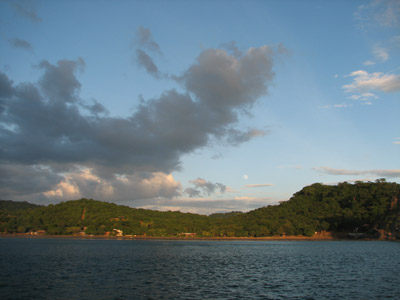
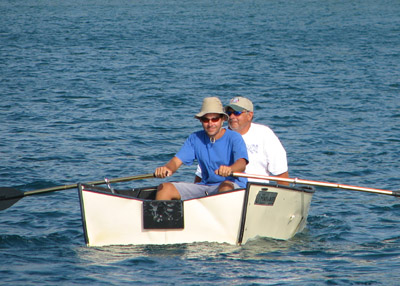
The next hop down the coast was to San Juan Del Sur, which sounded like it might be a kind of cool spot to check out. The town is the big beach “tourist†town in Nicaragua, but we found it to be rather sleepy, really. We spoke with the navy there and discovered that we would be able to stay the night (even a couple nights if we wanted) and go to shore and get a new zarpe and we would not have to take a bus to the border to do the whole immigration/customs bit. The guy assured us that all we had to do was give the port captain a call Sunday morning—“6am no hay problemoâ€â€”and they would actually come out to us (!) to give us our new zarpe. Well, okay! The next morning we called and called with no answer until finally we rowed ashore to get the zarpe. The captain and all the navy guys were watching some action movie at top volume and by the time we got the clearance to leave, it was pushing eleven o’clock.
We sailed off our anchor and headed for Bahia Santa Elena, of which we have heard excellent things. The sail was fast and smooth and we caught the biggest Sierra we have ever seen right at the border of Nicaragua. That way if the Costa Rican Navy came, we could say—OH, that fish we caught in Nicaragua. They never came, of course, and we made it to Santa Elena right before it started to rain. Yay!
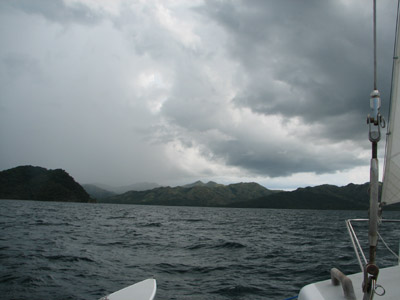
[Storm clouds over Bahia Santa Elena.]
